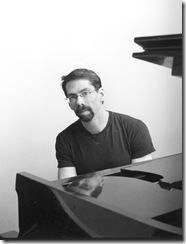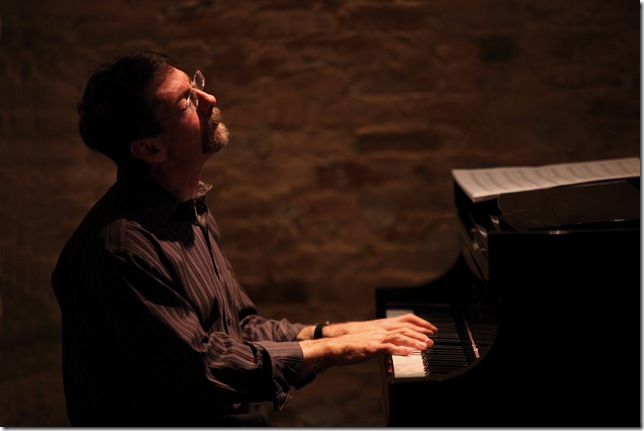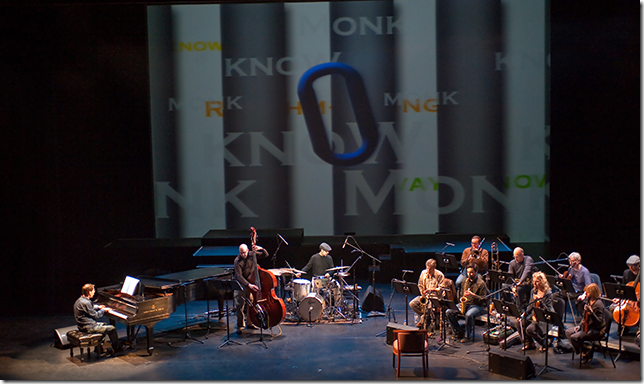If any musician gets chesty enough to think their work approaches impressionistic art, that they’ve overcome insurmountable obstacles to reach that plateau, and become a cultural icon in the process, you can bring them down to earth by matching their life against that of pianist Fred Hersch.
The 57-year-old native of Cincinnati was writing symphonies before high school, and relocated from the Midwest to study both jazz and classical music at the renowned New England Conservatory of Music in Boston. He then moved to New York City in 1977 at age 21, and cut his teeth playing with the likes of saxophonists Stan Getz, Joe Henderson and Lee Konitz, trumpeter Art Farmer, bassist Charlie Haden, and harmonica icon Toots Thielemans before starting his own recording career in the mid-1980s.
“That’s what you did back then,” Hersch says from his home in the SoHo area of lower Manhattan. “It wasn’t like now, when kids can record in their living rooms and start up their own labels and bands before they graduate college. I’d decided that I wanted to play with some of the best, and I was pretty driven, which paid off.”
Playing in Thielemans’ band yielded its acclaimed rhythm section of bassist Marc Johnson and drummer Joey Baron for Hersch’s critically lauded 1984 debut CD, Horizons. The trio format has been a relative constant since, along with nine introspective solo piano CDs. Hersch was the first pianist to play a week-long solo engagement at the Village Vanguard in the club’s 75-year history, and his second run there is documented on his latest solo release, the 2011 disc Alone at the Vanguard.
Alive at the Vanguard followed in 2012 with Hersch’s current trio (with bassist John Hebert and drummer Eric McPherson), which held a fascinating seminar in interplay and improvisation at the legendary Big Apple venue. The same trio makes stops in St. Petersburg, Sanibel and Fort Lauderdale from March 7-9.
“This trio has been all over Europe and the United States recently,” Hersch says, “and I’m really digging everything about it. It just keeps getting better. I love playing with those guys. And I don’t think I’ve played in Florida since I was in Toots’ band.”
The pianist has numerous other far-reaching and highly original works over his 30-year solo career, notably The French Collection (1989), Red Square Blue: Jazz Impressions of Russian Composers (1992), Songs We Know (1998), a duet with guitarist Bill Frisell; Fred Hersch Trio +2 (2004), Leaves of Grass (2005), and Whirl (2010), his first with Hebert and McPherson.
 “I’ve pretty much made it a rule that, if I do a project, the next one is not another of the same,” Hersch says. “It’s usually something different, even if it’s an extension of something I’d done previously.”
“I’ve pretty much made it a rule that, if I do a project, the next one is not another of the same,” Hersch says. “It’s usually something different, even if it’s an extension of something I’d done previously.”
Yet it may be easier for the uninitiated to understand Hersch’s depth and breadth through his tribute CDs. Many pianists are influenced by the lyricism, melody and impressionism of Bill Evans; others display some of the unorthodoxy, rhythmic prowess and spiked chords of Thelonious Monk, although seldom the twain shall meet. Hersch has recorded stellar salutes to each of the disparate giants, Evanessence: A Tribute to Bill Evans (1990) and Thelonious (1997). And his highly individual style includes touches of both, among numerous others.
If you want similarly varied additional composers, Hersch is equally adept on Plays Billy Strayhorn (1995), Plays Rodgers and Hammerstein (1996) and Plays Jobim (2009). Poetry? His evocative Leaves of Grass pays homage to the writings of Walt Whitman, with guest vocalists Kurt Elling and Kate McGarry. Visual art? There’s the 2012 CD Da Vinci, a series of duets with clarinetist Nico Gori.
Hersch may be, in fact, so versatile that comparisons to other fields of entertainment make more sense than music.
“Fred at the piano is like Lebron James on the basketball court,” says one of Hersch’s peers, fellow genre-bending New York City jazz pianist Jason Moran. “He’s perfection.”
The next Hersch release comes on March 12 in the form of Fun House, with fellow pianist Benoit Delbecq. It’s a unique double-trio recording with Delbecq, one of Europe’s rising experimental jazz artists, along with bassists Mark Helias and Jean-Jacques Avenel and drummers Gerry Hemingway and Steve Arguelles, who also adds live sampling. Hersch just recorded his Feb. 14-16 duet shows with 25-year-old guitarist Julian Lage at Jazz at Kitano in New York City for forthcoming release as well.
Lage’s prodigious talents were nurtured starting in his mid-teens by vibraphonist Gary Burton, a legendary musician and educator who also happens to be among a distinct group of openly gay jazz musicians. It’s a part of Hersch’s life that he also chose to open up about in the early 1990s, six years after he was diagnosed with HIV in 1986.
“I decided to come out in a significant way about it,” he says. “There’s a large price to be paid for keeping secrets, and on balance, there’s been many more positives than negatives for opening up about it.”
Yet in early 2008, the virus migrated to Hersch’s brain. The pianist suffered from AIDS-related dementia, hallucinating that everyone around him, even family members and his partner, Scott Morgan, were out to do him in. Tortuous for all parties, things came to a boil when Morgan had to rush Hersch to the hospital with pneumonia as all his organs started shutting down. Doctors used a medically induced coma to save his life, but he required a tracheotomy, plus regular dialysis as he lost renal function.
“The whole year was pretty much a wreck,” Hersch says. “I recovered from the virus attacking my brain to do pretty well in April and May, but then a sore throat turned into pneumonia. I was admitted to the hospital in complete septic shock and near death on June 10. They revived me and put me in a coma to eventually clear up all of the complications, and I finally got out on August 7. But I could no longer walk or talk, and had to be on a feeding tube rather than food and water for eight months. I also needed
one month of inpatient rehab and extensive swallowing therapy.”
The piano became another work in progress. Hersch remembered how to play, but initially had trouble connecting the dots, both mentally and physically.
“I was worried that I wouldn’t be able to play at an elite level,” he says. “It took me awhile, because my hands were pretty much the last thing to come back, plus my memory was dodgy. I was pretty weak, but I started gigging again as things came back to me, and as the year progressed I played more and more and got better. Do I play differently now? Maybe. I might have anyway, though, since one’s technique usually starts to settle by the time they’re in their mid-to-late-50s. But Scott was there for me
through it all, 24/7, which was truly a blessing. I’m feeling great now.”
One of the things he has to feel great about is his complex multi-media show My Coma Dreams (www.mycomadreams.com), which premiered in 2011 and next plays tonight (March 2) at the Miller Theatre at Columbia University in New York City (in association with the Columbia University Program in Narrative Medicine).
In effect, it’s a modern requiem for the nearly dead. The presentation involves Hersch leading an 11-piece band, conducted by Gregg Kallor, as scriptwriter Herschel Garfein directs actor/singer Michael Winther, who plays the roles of both Hersch and Morgan. The work of animator Sarah Wickliffe, lighting designer Aaron Copp and video systems designer Eamonn Farrell adds to Hersch’s vivid, multi-hued dream world, which ranges from hushed cathedrals and luxurious airliners to runaway vehicles and Hersch being trapped in a cage while sitting next to Thelonious Monk. And the music ― a hybrid of everything from sophistication to whimsy, notation to improvisation, and classical to jazz, with every color of the spectrum in-between ― is quintessentially Hersch.
“It’s the biggest project I’ve ever done,” he says. “As an artist, I wanted to share some of the experiences that only I could know about. I had presented my dreams to Herschel, and he conceived them in this form. I was initially thinking of a mix of music and visuals, but that’s limited, because if there’s a video behind an orchestra, everyone is usually focused on the video. We didn’t want to be the soundtrack to a silent movie, so we came up with this more complicated visual element.”
“It was a bit of a family affair. I already knew Michael, and knew he was the guy for this role. And I’ve known Sarah, a very talented young animator, since she was born. Her mother is the jazz singer Roseanna Vitro, whom I’ve known since 1978. This was a huge challenge, but Sarah really stepped up and delivered. And the band for the Columbia University performance includes so many great New York City freelance musicians, like John Hebert, [trumpeter] Ralph Alessi, [drummer] John Hollenbeck, and lots of amazing string players.”
The production is too complicated to stage very often (no dates are yet scheduled beyond tonight), yet Hersch hopes to eventually document My Coma Dreams with a DVD release. But first, there’s an actual documentary being made about his 2008 plight, its aftermath, and the other events that led up to the production’s inimitable blend of music, cinema and theater.
The seeds for Fred Hersch Now were sewn when the pianist met Don Loeb, husband to New York City filmmaker Carrie Lozano, during a flight to San Francisco as Hersch was rehearsing for the premiere of My Coma Dreams. Lozano knew that she wanted to tell his serendipitous story; fellow Big Apple filmmaker Charlotte Lagarde also got involved, and within eight weeks the two were shooting behind the scenes that led up to the May 2011 debut of My Coma Dreams at the Kasser Theater in Montclair, N.J.
“They’re two really extraordinary filmmakers,” Hersch says, “who have been shooting for two-and-a-half years. There will be interviews, performance settings, backstage shots and lots of other material.”
Lozano and Lagarde were editing Fred Hersch Now in December and shooting Hersch’s latest live solo stint at the Village Vanguard for additional footage in January. )Follow their progress at www.fredherschfilm.com.)
Also an instructor, Hersch’s most prolific piano students include Brad Mehldau, who has filtered his mentor’s touch, feel and individuality into his own unique synthesis, and Ethan Iverson of The Bad Plus, the acoustic piano trio that confounds jazz purists by interspersing its originals and standards interpretations with covers of songs by rock bands like Rush and Black Sabbath. Hersch now pays it forward by teaching in his old stomping grounds, New England Conservatory.
“I was there back when Gunther Schuller was there,” he says, “and I also studied with Jaki Byard. My class of ’77 included a rather amazing roster of musicians, Marty Ehrlich, Jerome Harris, Anthony Coleman, Michael Moore. It was a great time to be there, and I now have some great students there who are coming up and are really going to do something. Many of them are already. It’s a good way to give back a little bit; a nice circle.”
Especially when a second lease on life was required to complete it. The painterly pianist, who’s never played at the Miniaci in Fort Lauderdale before, says he actually wants to see the room before he comes up with a set list for it.
“Regardless,” Hersch says, “listeners will get some of my original music; rearrangements of what we might call standards, and perhaps some material by jazz composers like Monk, Ornette Coleman and Wayne Shorter. Once I see the hall, I’ll make up a hodgepodge set right before we go up. Which will be subject to change on the fly.”
A lot like life itself, a fact that few know better than Hersch.
See the Fred Hersch Trio at 8 p.m. on March 9 at the Miniaci Performing Arts Center, Nova Southeastern University, Davie ($40, 954-462-0222).

